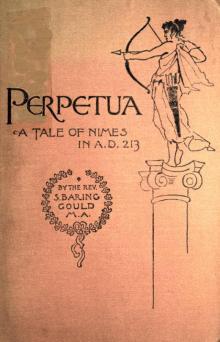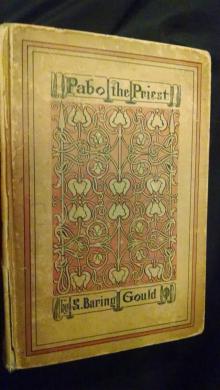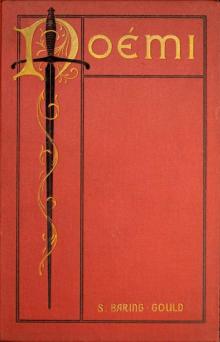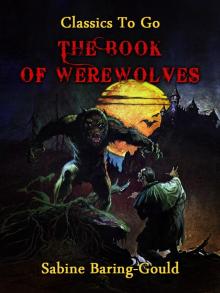- Home
- S. Baring-Gould
The Book of Were-Wolves Page 8
The Book of Were-Wolves Read online
Page 8
The Serbs connect the vampire and the were-wolf together, and call them by one name vlkoslak. These rage chiefly in the depths of winter: they hold their annual gatherings, and at them divest themselves of their wolf-skins, which they hang on the trees around them. If any one succeeds in obtaining the skin and burning it, the vlkoslak is thenceforth disenchanted.
The power to become a were-wolf is obtained by drinking the water which settles in a foot-print left in clay by a wolf.
Among the White Russians the wawkalak is a man who has incurred the wrath of the devil, and the evil one punishes him by transforming him into a wolf and sending him among his relations, who recognize him and feed him well. He is a most amiably disposed were-wolf, for he does no mischief, and testifies his affection for his kindred by licking their hands. He cannot, however, remain long in any place, but is driven from house to house, and from hamlet to hamlet, by an irresistible passion for change of scene. This is an ugly superstition, for it sets a premium on standing well with the evil one.
The Sloyakians merrily term a drunkard a vlkodlak, because, forsooth, he makes a beast of himself. A Slovakian household were-wolf tale closes this chapter.
The Poles have their were-wolves, which rage twice in the year--at Christmas and at midsummer.
According to a Polish story, if a witch lays a girdle of human skin on the threshold of a house in which a marriage is being celebrated, the bride and bridegroom, and bridesmaids and groomsmen, should they step across it, are transformed into wolves. After three years, however, the witch will cover them with skins with the hair. turned outward; immediately they will recover their natural form. On one occasion, a witch cast a skin of too scanty dimensions over the bridegroom, so that his tail was left uncovered: he resumed his human form, but retained his lupine caudal appendage {i.e. tail--jbh}.
The Russians call the were-wolf oborot, which signifies "one transformed." The following receipt is given by them for becoming one.
"He who desires to become an oborot, let him seek in the forest a hewn-down tree; let him stab it with a small copper knife, and walk round the tree, repeating the following incantation:--
On the sea, on the ocean, on the island, on Bujan,
On the empty pasture gleams the moon, on an ashstock lying
In a green wood, in a gloomy vale.
Toward the stock wandereth a shaggy wolf.
Horned cattle seeking for his sharp white fangs;
But the wolf enters not the forest,
But the wolf dives not into the shadowy vale,
Moon, moon, gold-horned moon,
Cheek the flight of bullets, blunt the hunters' knives,
Break the shepherds' cudgels,
Cast wild fear upon all cattle,
On men, on all creeping things,
That they may not catch the grey wolf,
That they may not rend his warm skin
My word is binding, more binding than sleep,
More binding than the promise of a hero!
"Then he springs thrice over the tree and runs into the forest, transformed into a wolf." %note%1
[1. SACHAROW: Inland, 1838, No. 17.]
In the ancient Bohemian Lexicon of Vacerad (A. D. 1202) the were-wolf is called vilkodlak, and is explained as faunus. Safarik says under that head,-
"Incubi sepe improbi existunt mulieribus, et earum peragunt concubitum, quos demones Galli dusios nuncupant." And in another place: "Vilkodlaci, incubi, sive invidi, ab inviando passim cum animalibus, unde et incubi dicuntur ab incubando homines, i. e. stuprando, quos Romani faunos ficarios dicunt."
That the same belief in lycanthropy exists in Armenia is evident from the following story told by Haxthausen, in his Trans-Caucasia (Leipzig, i. 322):--"A man once saw a wolf, which had carried off a child, dash past him. He pursued it hastily, but was unable to overtake it. At last he came upon the hands and feet of a child, and a little further on he found a cave, in which lay a wolf-skin. This he cast into a fire, and immediately a woman appeared, who howled and tried to rescue the skin from the flames. The man, however, resisted, and, as soon as the hide was consumed, the woman had vanished in the smoke."
In India, on account of the prevalence of the doctrine of metempsychosis, the belief in transformation is widely diffused. Traces of genuine lycanthropy are abundant in all regions whither Buddism has reached. In Ceylon, in Thibet, and in China, we find it still forming a portion of the national creed.
In the Pantschatantra is a story of an enchanted Brahmin's son, who by day was a serpent, by night a man.
Vikramâditya's father, the son of Indra, was condemned to be an ass by day and a man by night.
A modern Indian tale is to this effect:--A prince marries a female ape, but his brothers wed handsome princesses. At a feast given by the queen to her stepdaughters, there appears an exquisitely beautiful lady in gorgeous robes. This is none other than the she-ape, who has laid aside her skin for the occasion: the prince slips out of the room and burns the skin, so that his wife is prevented from resuming her favourite appearance.
Nathaniel Pierce %note%1 gives an account of an Abyssinian superstition very similar to that prevalent in Europe.
[1. Life and Adventures of Nathaniel Pierce, written by himself during a residence in Abyssinia from 1810-19. London, 1831.]
He says that in Abyssinia the gold. and silversmiths are highly regarded, but that the ironworkers are looked upon with contempt, as an inferior grade of beings. Their kinsmen even ascribe to them the power of transforming themselves into hyænas, or other savage beasts. All convulsions and hysterical disorders are attributed to the effect of their evil eye. The Amhara call them Buda, the Tigré, Tebbib. There are also Mahomedan and Jewish Budas. It is difficult to explain the origin of this strange superstition. These Budas are distinguished from other people by wearing gold ear-rings, and Coffin declares that he has often found hyænas with these rings in their ears, even among the beasts which he has shot or speared himself. But how the rings got into their ears is more than Coffin was able to ascertain.
Beside their power to transform themselves into hyænas or other wild beasts, all sorts of other strange things are ascribed to them; and the Abyssinians are firmly persuaded that they rob the graves by midnight, and no one would venture to touch what is called quanter, or dried meat in their houses, though they would not object to partake of fresh meat, if they had seen the animal, from which it came, killed before them. Coffin relates, as eye-witness of the fact, the following story:--
Among his servants was a Buda, who, one evening, whilst it was still light, came to his master and asked leave of absence till the following morning. He obtained the required leave and departed; but scarcely had Coffin turned his head, when one of his men exclaimed,--"Look! there he is, changing himself into hyæna," pointing in the direction taken by the Buda. Coffin turned to look, and although he did not witness the process of transformation, the young man had vanished from the spot on which he had been standing, not a hundred paces distant, and in his place was a hyæna running away. The place was a plain without either bush or tree to impede the view. Next morning the young man returned, and was charged by his companions with the transformation: this he rather acknowledged than denied, for he excused himself on the plea that it was the habit of his class. This statement of Pierce is corroborated by a note contributed by Sir Gardner Wilkinson to Rawlinson's Herodotus (book iv. chap. 105). "A class of people in Abyssinia are believed to change themselves into hyænas when they like. On my appearing to discredit it, I was told by one who lived for years there, that no well-informed person doubted it, and that he was once walking with one of them, when he happened to look away for a moment, and on turning again towards his companion, he saw him trotting off in the shape of a hyæna. He met him afterwards in his old form. These worthies are blacksmiths.--G. W."
A precisely similar superstition seems to have existed in America, for Joseph Acosta (Hist. Nat. des Indes) relates that the ruler of a city in Mexico, w
ho was sent for by the predecessor of Montezuma, transformed himself, before the eyes of those who were sent to seize him, into an eagle, a tiger, and an enormous serpent. He yielded at last, and was condemned to death. No longer in his own house, he was unable to work miracles so as to save his life. The Bishop of Chiapa, a province of Guatemala, in a writing published in 1702, ascribes the same power to the Naguals, or national priests, who laboured to bring back to the religion of their ancestors, the children brought up as Christians by the government. After various ceremonies, when the child instructed advanced to embrace him, the Nagual suddenly assumed a frightful aspect, and under the form of a lion or tiger, appeared chained to the young Christian convert.--(Recueil de Voyages, tom. ii. 187.)
Among the North American Indians, the belief in transformation is very prevalent. The following story closely resembles one very prevalent all over the world.
"One Indian fixed his residence on the borders of the Great Bear lake, taking with him only a dog big with young. In due time, this dog brought forth eight pups. Whenever the Indian went out to fish, he tied up the pups, to prevent the straying of the litter. Several times, as he approached his tent, he heard noises proceeding from it, which sounded like the talking, the laughing, the crying, the wail, and the merriment of children; but, on entering it, he only perceived the pups tied up as usual. His curiosity being excited by the noises he had heard, he determined to watch and learn whence these sounds proceeded, and what they were. One day he pretended to go out to fish, but, instead of doing so, he concealed himself in a convenient place. In a short time he again heard -voices, and, rushing suddenly into the tent, beheld some beautiful children sporting and laughing, with the dog-skins lying by their side. He threw the dog-skins into the fire, and the children, retaining their proper forms, grew up, and were the ancestors of the dog-rib nation."--(Traditions of the North American Indians, by T. A. Jones, 1830, Vol. ii. p. 18.)
In the same work is a curious story entitled The Mother of the World, which bears a close analogy to another world-wide myth: a woman marries a dog, by night the dog lays aside its skin, and appears as a man. This may be compared with the tale of Björn and Bera already given.
I shall close this chapter with a Slovakian household tale given by T. T. Hanush in the third volume of Zeitschrift für Deutsche Mythologie.
The Daughter of the Vlkolak
"There was once a father, who had nine daughters, and they were all marriageable, but the youngest was the most beautiful. The father was a were-wolf. One day it came into his head: 'What is the good of having to support so many girls?' so he determined to put them all out of the way.
"He went accordingly into the forest to hew wood, and he ordered his daughters to let one of them bring him his dinner. It was the eldest who brought it.
"'Why, how come you so early with the food?' asked the woodcutter.
"'Truly, father, I wished to strengthen you, lest you should fall upon us, if famished!'
"'A good lass! Sit down whilst I eat.' He ate, and whilst he ate he thought of a scheme. He rose and said: I My girl, come, and I will show you a pit I have been digging.'
"'And what is the pit for? '
"'That we may be buried in it when we die, for poor folk will not be cared for much after they are dead and gone.'
"So the girl went with him to the side of the deep pit. 'Now hear,' said the were-wolf, 'you must die and be cast in there.'
"She begged for her life, but all in vain, so he laid hold of her and cast her into the grave. Then he took a great stone and flung it in upon her and crushed her head, so the poor thing breathed out her soul. When the were-wolf had done this he went back to his work, and as dusk came on, the second daughter arrived, bringing him food. He told her of the pit, and brought her to it, and cast her in, and killed her as the first. And so he dealt with all his girls up to the last. The youngest knew well that her father was a were-wolf, and she was grieved that her sisters did not return; she thought, 'Now where can they be? Has my father kept them for companionship; or to help him in his work?' So she made the food which she was to take him, and crept cautiously through the wood. When she came near the place where her father worked, she heard his strokes felling timber, and smelt smoke. She saw presently a large fire and two human heads roasting at it. Turning from the fire, she went in the direction of the axe-strokes, and found her father.
"See,' said she, 'father, I have brought you food.'
"That is a good lass,' said he. 'Now stack the wood for me whilst I eat.'
"'But where are my sisters?' she asked.
"'Down in yon valley drawing wood,' he replied 'follow me, and I will bring you to them.'
"They came to the pit; then he told her that he had dug it for a grave. 'Now,' said he, 'you must die, and be cast into the pit with your sisters. '
"'Turn aside, father,' she asked, 'whilst I strip of my clothes, and then slay me if you will.'
"He turned aside as she requested, and then--tchich! she gave him a push, and he tumbled headlong into the hole he had dug for her.
"She fled for her life, for the were-wolf was not injured, and he soon would scramble out of the pit.
"Now she hears his howls resounding through the gloomy alleys of the forest, and swift as the wind she runs. She hears the tramp of his approaching feet, and the snuffle of his breath. Then she casts behind her her handkerchief. The were-wolf seizes this with teeth and nails, and rends it till it is reduced to tiny ribands. In another moment he is again in pursuit foaming at the mouth, and howling dismally, whilst his red eyes gleam like burning coals. As he gains on her, she casts behind her her gown, and bids him tear that. He seizes the gown and rives it to shreds, then again he pursues. This time she casts behind her her apron, next her petticoat, then her shift, and at last rums much in the condition in which she was born. Again the were-wolf approaches; she bounds out of the forest into a hay-field, and hides herself in the smallest heap of hay. Her father enters the field, runs howling about it in search of her, cannot find her, and begins to upset the different haycocks, all the while growling and gnashing his gleaming white fangs in his rage at her having escaped him. The foam flakes drop at every step from his mouth, and his skin is reeking with sweat. Before he has reached the smallest bundle of hay his strength leaves him, he feels exhaustion begin to creep over him, and he retires to the forest.
"The king goes out hunting every clay; one of his dogs carries food to the hay-field, which has most unaccountably been neglected by the hay-makers for three days. The king, following the dog, discovers the fair damsel, not exactly 'in the straw,' but up to her neck in hay. She is carried, hay and all, to the palace, where she becomes his wife, making only one stipulation before becoming his bride, and that is, that no beggar shall be permitted to enter the palace.
"After some years a beggar does get in, the beggar being, of course, none other than her were-wolf father. He steals upstairs, enters the nursery, cuts the throats of the two children borne by the queen to her lord, and lays the knife under her pillow.
"In the morning, the king, supposing his wife to be the murderess, drives her from home, with the dead princes hung about her neck. A hermit comes to the rescue, and restores the babies to life. The king finds out his mistake, is reunited to the lady out of the hay, and the were-wolf is cast off a high cliff into the sea, and that is the end of him. The king, the queen, and the princes live happily, and may be living yet, for no notice of their death has appeared in the newspaper."
This story bears some resemblance to one told by Von Hahn in his Griechische und Albanesische Märchen; I remember having heard a very similar one in the Pyrenees; but the man who flies from the were-wolf is one who, after having stripped off all his clothes, rushes into a cottage and jumps into a bed. The were-wolf dares not, or cannot, follow. The cause of his flight was also different. He was a freemason who had divulged the secret, and the were-wolf was the master of his lodge in pursuit of him. In the Bearnais story, there is nothing similar
to the last part of the Slovakian tale, and in the Greek one the transformation and the pursuit are omitted, though the woman-eater is called "dog's-head," much as an outlaw in the north of Europe was said to be wolf-headed.
It is worthy of notice in the tale of The Daughter of the Ulkolak, that the were-wolf fit is followed by great exhaustion, %note%1 and that the wolf is given clothes to tear, much as in the Danish stories already related. There does not seem to be any indication of his Laving changed his shape, at least no change is mentioned, his hands are spoken of, and he swears and curses his daughter in broad Slovakian. The fit very closely resembles that to which Skallagrim, the Icelander, was subject. It is a pity that the maid Bràk in the Icelandic tale did not fall upon her legs like the young lady in the hay.
[1. Compare this with the exhaustion following a Berserkir fit, and that which succeeded the attacks to which M. Bertrand was subject.]
CHAPTER IX.
NATURAL CAUSES OF LYCANTHROPY.
Innate Cruelty--Its Three Forms--Dumollard--Andreas Bichel--A Dutch Priest--Other instances of Inherent Cruelty--Cruelty united to Refinement--A Hungarian Bather in Blood--Suddenness with which the Passion is developed--Cannibalism; in pregnant Women; in Maniacs--Hallucination; how Produced--Salves--The Story of Lucius--Self-deception.
WHAT I have related from the chronicles of antiquity, or from the traditional lore of the people, is veiled under the form of myth or legend; and it is only from Scandinavian descriptions of those afflicted with the wolf-madness, and from the trials of those charged with the crime of lycanthropy in the later Middle Ages, that we can arrive at the truth respecting that form of madness which was invested by the superstitious with so much mystery.

 Perpetua. A Tale of Nimes in A.D. 213
Perpetua. A Tale of Nimes in A.D. 213 Domitia
Domitia Pabo, the Priest: A Novel
Pabo, the Priest: A Novel Noémi
Noémi The Book of Were-Wolves
The Book of Were-Wolves